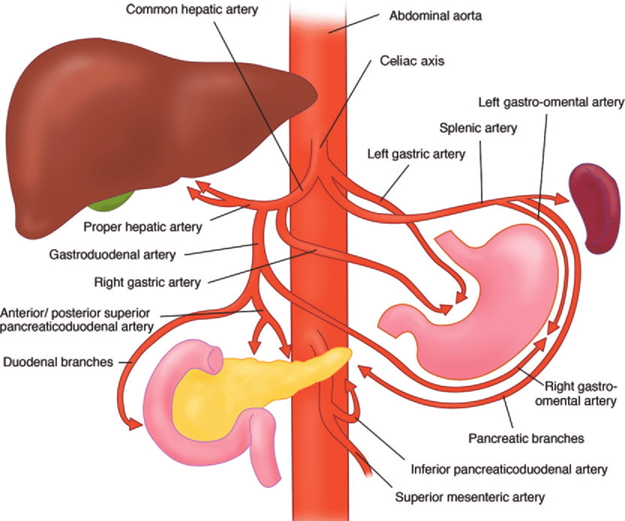The artery that provides blood to both the liver and spleen is the:
Celiac.
Brachiocephalic.
Renal.
Tibial.
The Correct Answer is A
The celiac artery supplies blood to the liver, spleen, and stomach.

It is one of the three major branches of the abdominal aorta, along with the superior mesenteric artery and the inferior mesenteric artery.
The celiac artery divides into three branches: the left gastric artery, the splenic artery, and the common hepatic artery.
Choice B is wrong because the brachiocephalic artery is a large vessel that arises from the aortic arch and supplies blood to the right side of the head and neck and the right arm.
It has no connection to the liver or spleen.
Choice C is wrong because the renal arteries are paired vessels that arise from the abdominal aorta and supply blood to the kidneys.
They are located below the superior mesenteric artery and above the inferior mesenteric artery.
Choice D is wrong because the tibial arteries are branches of the popliteal artery that supply blood to the lower leg and foot.
They are located in the posterior and anterior compartments of the leg.
The normal range of blood pressure in the celiac artery is about 100-120 mmHg systolic and 60-80 mmHg diastolic.
The normal range of blood flow in the celiac artery is about 200-300 ml/min. The normal diameter of the celiac artery is about 5-7 mm.
Nursing Test Bank
Naxlex Comprehensive Predictor Exams
Related Questions
Correct Answer is B
Explanation
The hypothalamus is the part of the brain that produces hormones that control the pituitary gland.
The pituitary gland then releases hormones that target other endocrine glands, such as the thyroid, adrenal, and gonads.
Therefore, the hypothalamus is the source of releasing hormones for target cells in the anterior pituitary gland.
Choice A is wrong because the anterior pituitary gland does not produce releasing hormones, but responds to them by secreting other hormones.
Choice C is wrong because the thyroid gland does not produce releasing hormones, but responds to them by secreting thyroid hormones.
Choice D is wrong because the posterior pituitary gland does not produce releasing hormones, but stores and releases hormones made by the hypothalamus, such as oxytocin and antidiuretic hormone.
Correct Answer is B
Explanation
Kidney disease can cause hypertension by activating the renin-angiotensin mechanism.
This mechanism involves the release of renin from the kidneys, which stimulates the production of angiotensin II, a hormone that constricts blood vessels and increases blood pressure.
Choice A is wrong because kidney disease does not directly signal the brain stem to increase blood pressure.
The brain stem regulates blood pressure through the autonomic nervous system, which responds to various stimuli such as stress, pain, or emotions.
Choice C is wrong because kidney disease does not increase the release (excretion) of sodium and water.
On the contrary, kidney disease can impair the ability of the kidneys to filter out excess sodium and water, which can lead to fluid retention and increased blood pressure.
Choice D is wrong because kidney disease does not stimulate the secretion of ANP.
ANP stands for atrial natriuretic peptide, a hormone that is secreted by the heart when it senses high blood pressure.
ANP causes the kidneys to excrete more sodium and water, which lowers blood pressure.
Whether you are a student looking to ace your exams or a practicing nurse seeking to enhance your expertise , our nursing education contents will empower you with the confidence and competence to make a difference in the lives of patients and become a respected leader in the healthcare field.
Visit Naxlex, invest in your future and unlock endless possibilities with our unparalleled nursing education contents today
Report Wrong Answer on the Current Question
Do you disagree with the answer? If yes, what is your expected answer? Explain.
Kindly be descriptive with the issue you are facing.
